Leadership, Team Dynamics, and Performance in Tesco's OB
VerifiedAdded on 2023/06/18
|21
|1829
|340
Report
AI Summary
This report examines organisational behaviour within Tesco, a multinational retail organisation, focusing on the relationship between organisational structure and performance. It explores various organisational structures such as functional, divisional, matrix, team, and network structures, highlighting their impact on operational effectiveness. The report further analyses the role of managers and the skills they can apply to ensure operational efficiency, including communication, leadership, and team-building skills. It investigates how leadership can inspire and motivate staff members to improve performance through vision, communication, clear goals, leading by example, encouraging teamwork, and providing praise and rewards. Factors influencing group and team behaviour, such as social interaction, perception, interdependence, favouritism, and commonality of purpose, are also discussed, along with Bruce Tuckman's model of team development. The report concludes that understanding organisational behaviour is crucial for companies to achieve their goals and objectives.
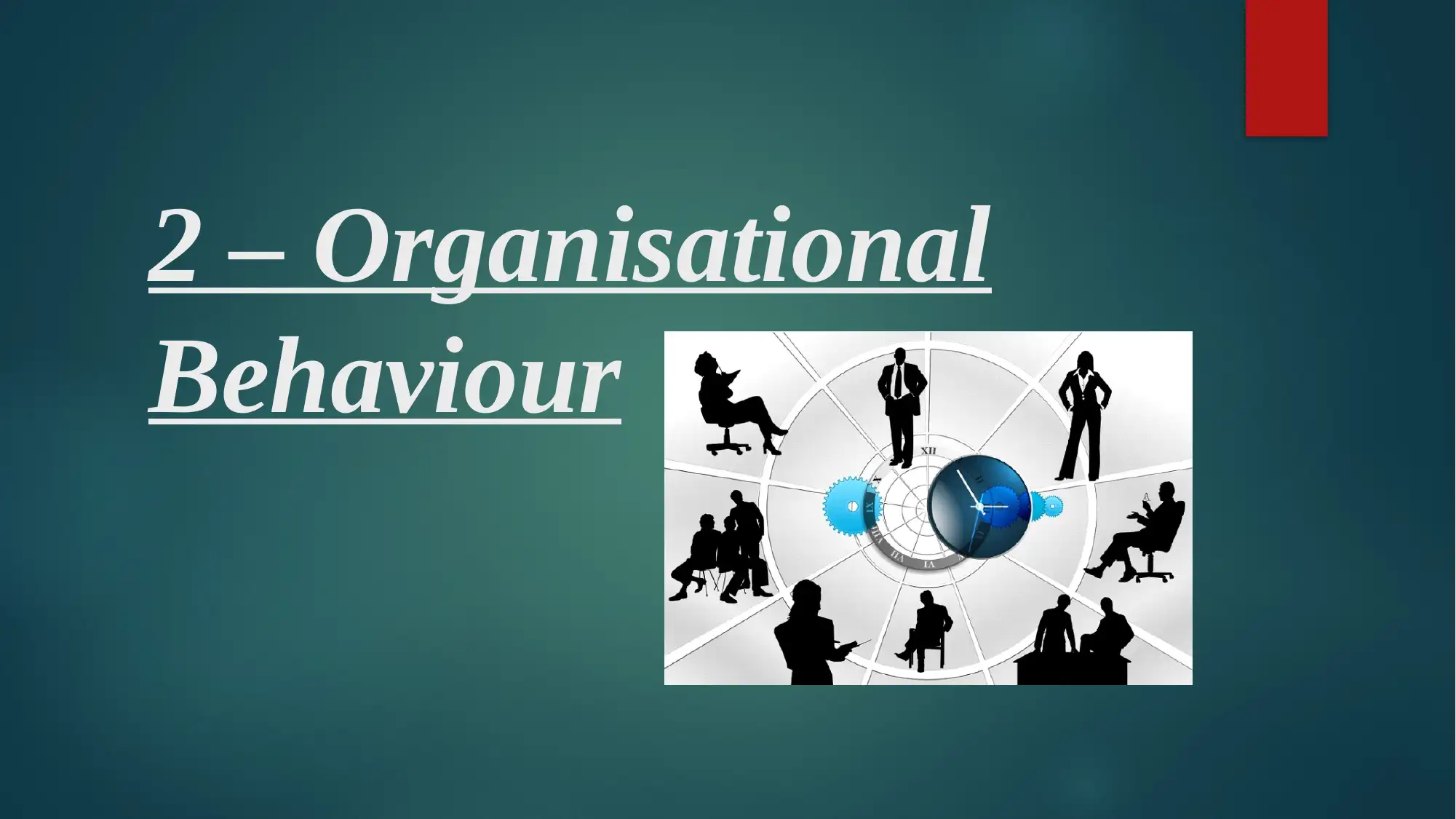
2 – Organisational
Behaviour
Behaviour
Paraphrase This Document
Need a fresh take? Get an instant paraphrase of this document with our AI Paraphraser
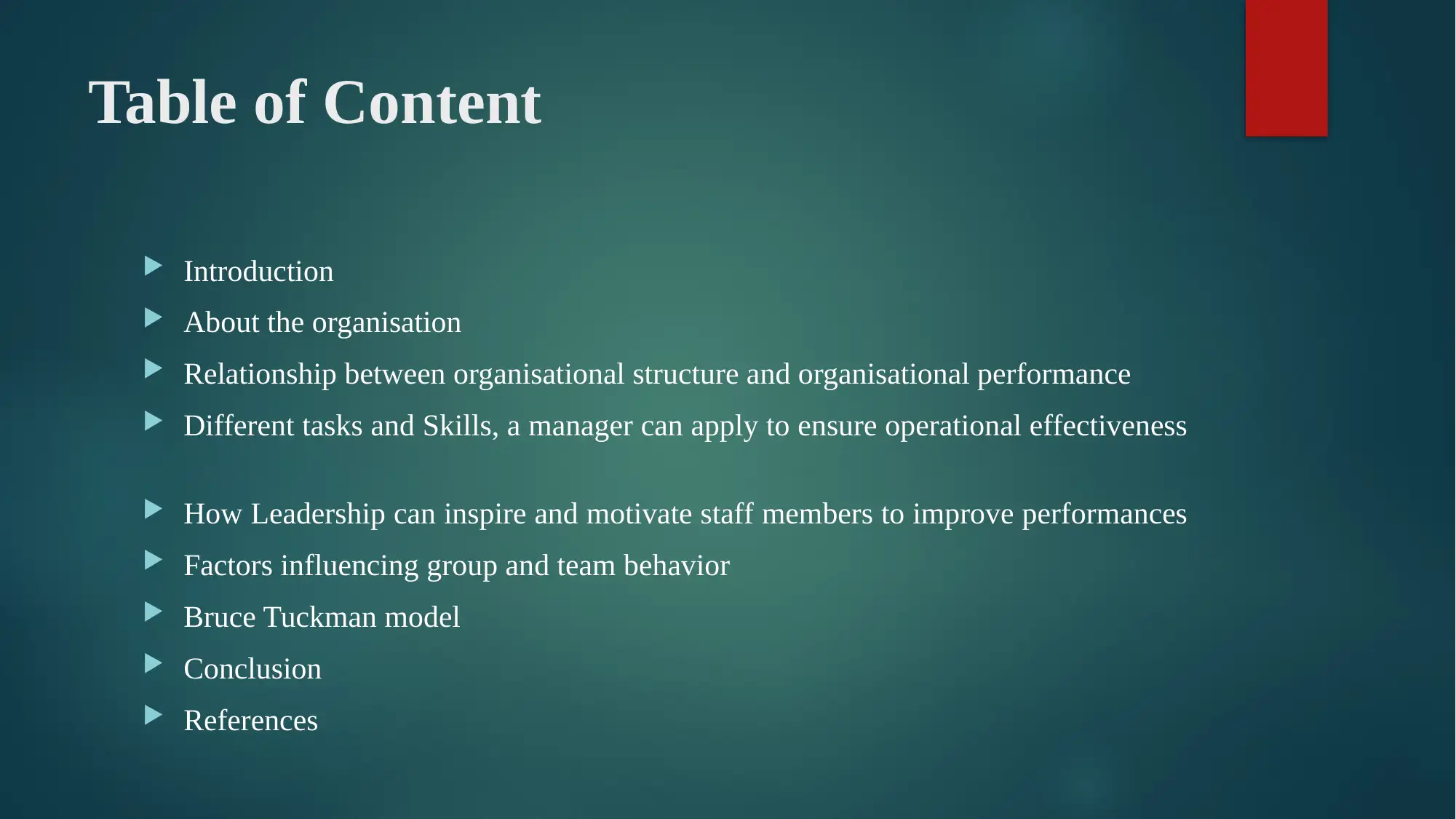
Table of Content
Introduction
About the organisation
Relationship between organisational structure and organisational performance
Different tasks and Skills, a manager can apply to ensure operational effectiveness
How Leadership can inspire and motivate staff members to improve performances
Factors influencing group and team behavior
Bruce Tuckman model
Conclusion
References
Introduction
About the organisation
Relationship between organisational structure and organisational performance
Different tasks and Skills, a manager can apply to ensure operational effectiveness
How Leadership can inspire and motivate staff members to improve performances
Factors influencing group and team behavior
Bruce Tuckman model
Conclusion
References
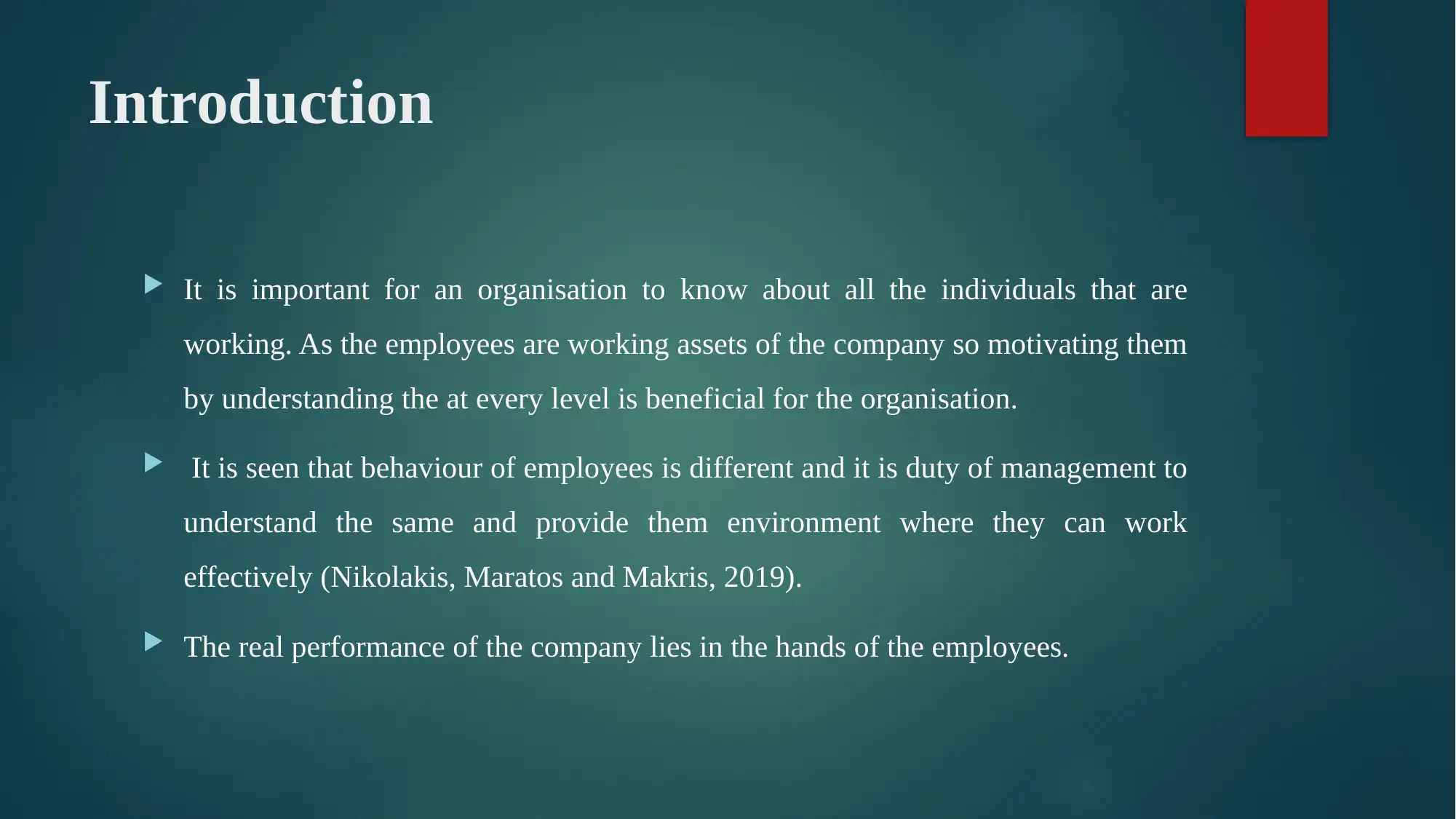
Introduction
It is important for an organisation to know about all the individuals that are
working. As the employees are working assets of the company so motivating them
by understanding the at every level is beneficial for the organisation.
It is seen that behaviour of employees is different and it is duty of management to
understand the same and provide them environment where they can work
effectively (Nikolakis, Maratos and Makris, 2019).
The real performance of the company lies in the hands of the employees.
It is important for an organisation to know about all the individuals that are
working. As the employees are working assets of the company so motivating them
by understanding the at every level is beneficial for the organisation.
It is seen that behaviour of employees is different and it is duty of management to
understand the same and provide them environment where they can work
effectively (Nikolakis, Maratos and Makris, 2019).
The real performance of the company lies in the hands of the employees.
⊘ This is a preview!⊘
Do you want full access?
Subscribe today to unlock all pages.

Trusted by 1+ million students worldwide
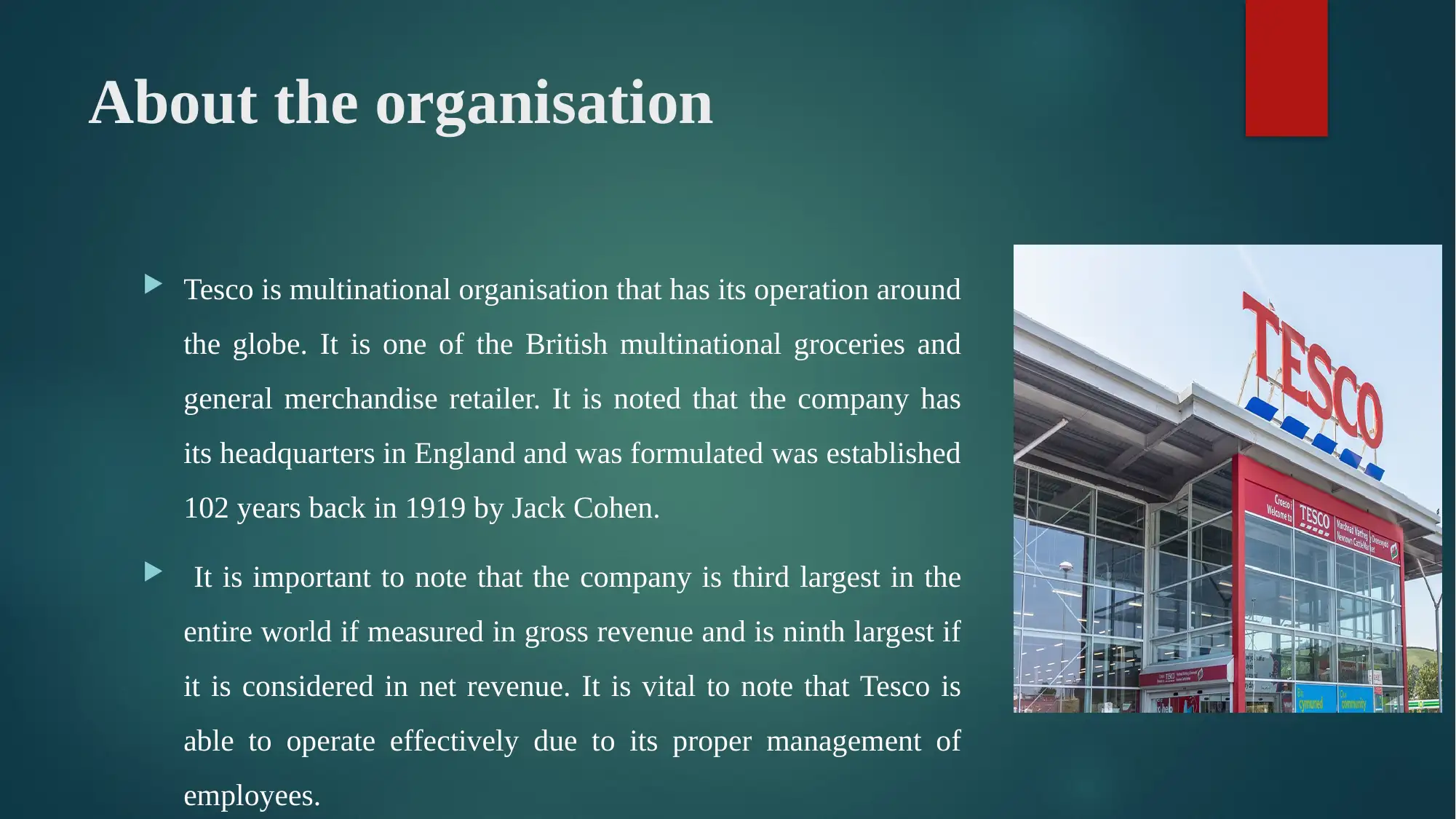
About the organisation
Tesco is multinational organisation that has its operation around
the globe. It is one of the British multinational groceries and
general merchandise retailer. It is noted that the company has
its headquarters in England and was formulated was established
102 years back in 1919 by Jack Cohen.
It is important to note that the company is third largest in the
entire world if measured in gross revenue and is ninth largest if
it is considered in net revenue. It is vital to note that Tesco is
able to operate effectively due to its proper management of
employees.
Tesco is multinational organisation that has its operation around
the globe. It is one of the British multinational groceries and
general merchandise retailer. It is noted that the company has
its headquarters in England and was formulated was established
102 years back in 1919 by Jack Cohen.
It is important to note that the company is third largest in the
entire world if measured in gross revenue and is ninth largest if
it is considered in net revenue. It is vital to note that Tesco is
able to operate effectively due to its proper management of
employees.
Paraphrase This Document
Need a fresh take? Get an instant paraphrase of this document with our AI Paraphraser
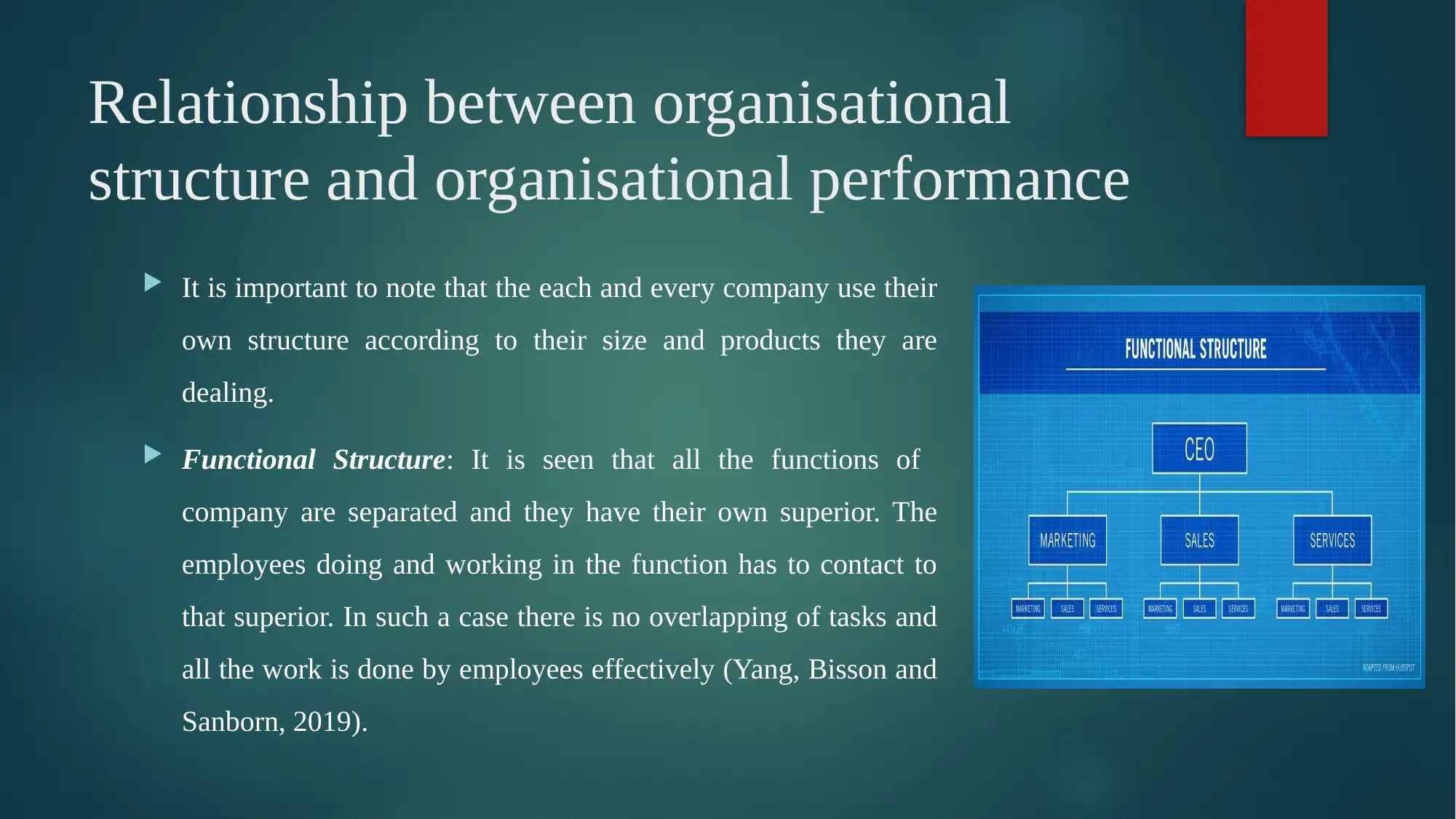
Relationship between organisational
structure and organisational performance
It is important to note that the each and every company use their
own structure according to their size and products they are
dealing.
Functional Structure: It is seen that all the functions of
company are separated and they have their own superior. The
employees doing and working in the function has to contact to
that superior. In such a case there is no overlapping of tasks and
all the work is done by employees effectively (Yang, Bisson and
Sanborn, 2019).
structure and organisational performance
It is important to note that the each and every company use their
own structure according to their size and products they are
dealing.
Functional Structure: It is seen that all the functions of
company are separated and they have their own superior. The
employees doing and working in the function has to contact to
that superior. In such a case there is no overlapping of tasks and
all the work is done by employees effectively (Yang, Bisson and
Sanborn, 2019).
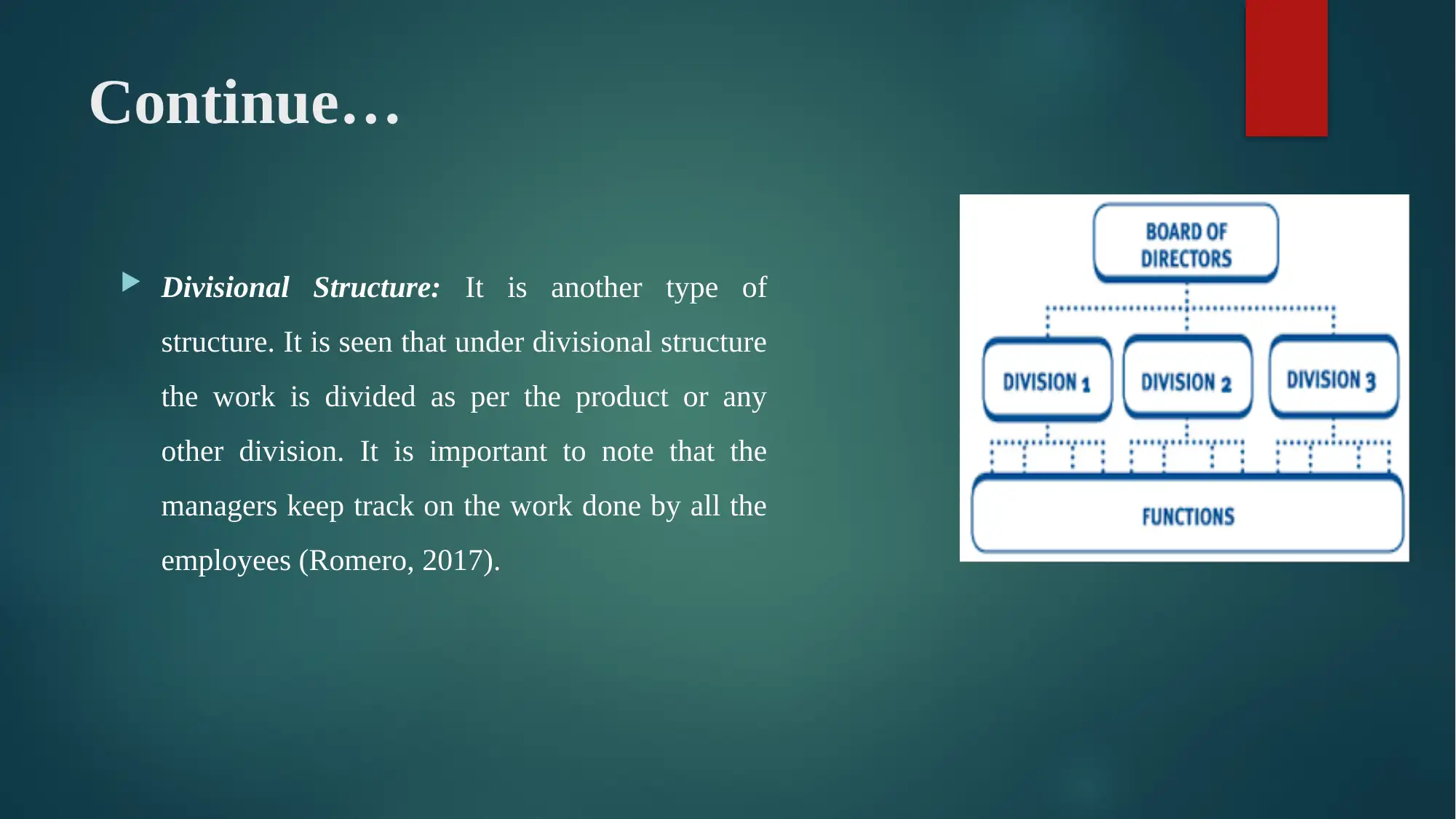
Continue…
Divisional Structure: It is another type of
structure. It is seen that under divisional structure
the work is divided as per the product or any
other division. It is important to note that the
managers keep track on the work done by all the
employees (Romero, 2017).
Divisional Structure: It is another type of
structure. It is seen that under divisional structure
the work is divided as per the product or any
other division. It is important to note that the
managers keep track on the work done by all the
employees (Romero, 2017).
⊘ This is a preview!⊘
Do you want full access?
Subscribe today to unlock all pages.

Trusted by 1+ million students worldwide
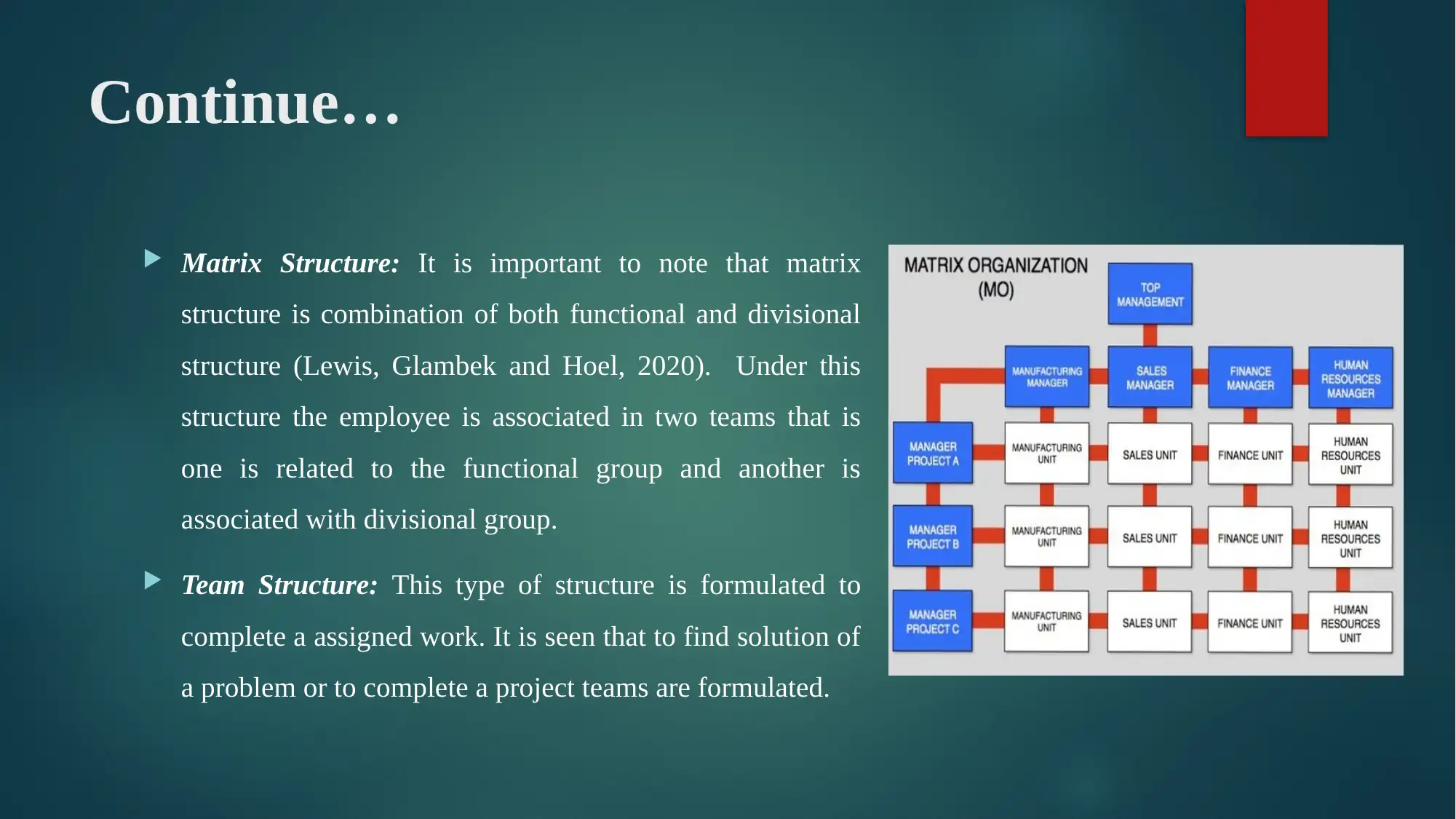
Continue…
Matrix Structure: It is important to note that matrix
structure is combination of both functional and divisional
structure (Lewis, Glambek and Hoel, 2020). Under this
structure the employee is associated in two teams that is
one is related to the functional group and another is
associated with divisional group.
Team Structure: This type of structure is formulated to
complete a assigned work. It is seen that to find solution of
a problem or to complete a project teams are formulated.
Matrix Structure: It is important to note that matrix
structure is combination of both functional and divisional
structure (Lewis, Glambek and Hoel, 2020). Under this
structure the employee is associated in two teams that is
one is related to the functional group and another is
associated with divisional group.
Team Structure: This type of structure is formulated to
complete a assigned work. It is seen that to find solution of
a problem or to complete a project teams are formulated.
Paraphrase This Document
Need a fresh take? Get an instant paraphrase of this document with our AI Paraphraser
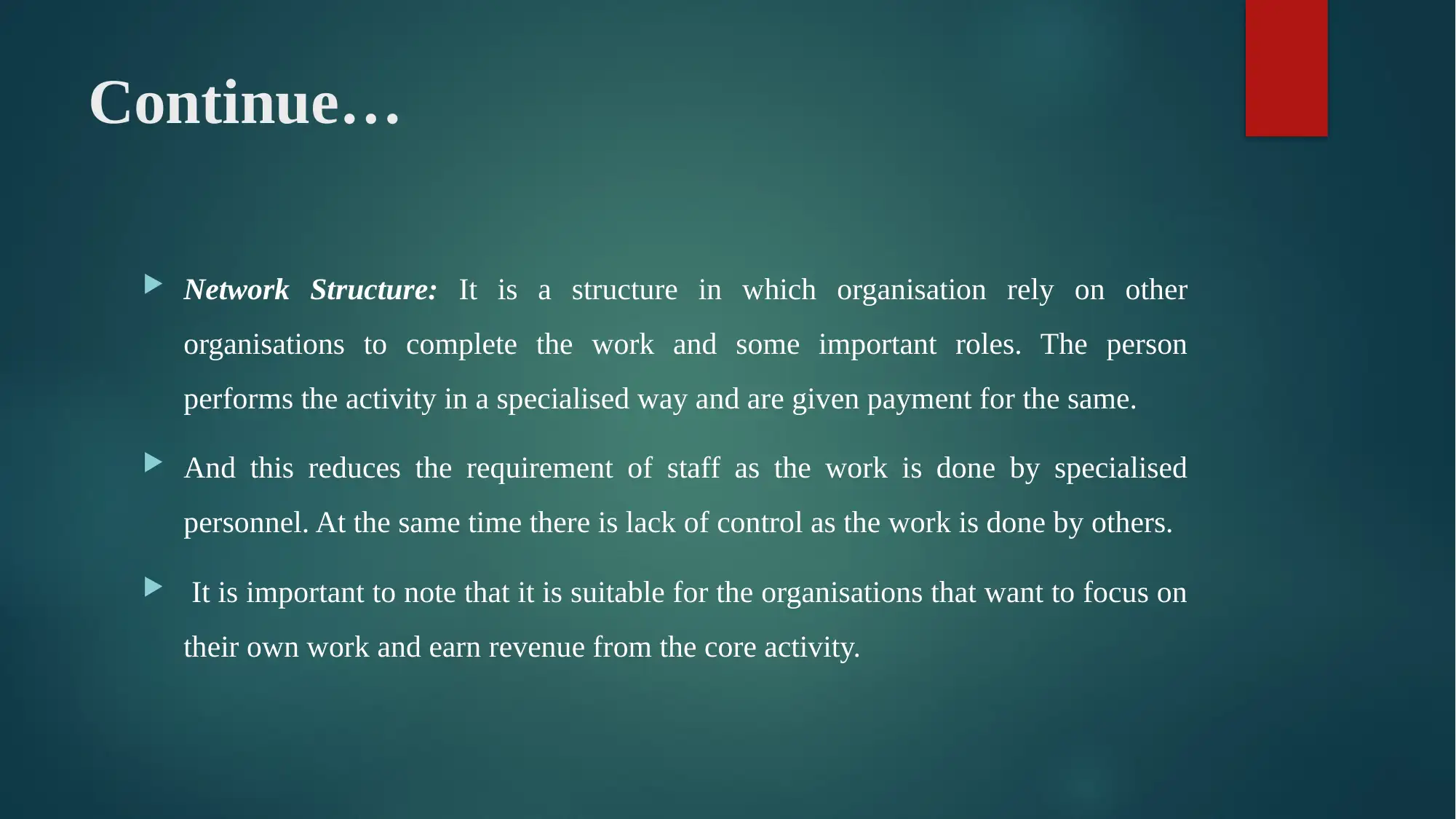
Continue…
Network Structure: It is a structure in which organisation rely on other
organisations to complete the work and some important roles. The person
performs the activity in a specialised way and are given payment for the same.
And this reduces the requirement of staff as the work is done by specialised
personnel. At the same time there is lack of control as the work is done by others.
It is important to note that it is suitable for the organisations that want to focus on
their own work and earn revenue from the core activity.
Network Structure: It is a structure in which organisation rely on other
organisations to complete the work and some important roles. The person
performs the activity in a specialised way and are given payment for the same.
And this reduces the requirement of staff as the work is done by specialised
personnel. At the same time there is lack of control as the work is done by others.
It is important to note that it is suitable for the organisations that want to focus on
their own work and earn revenue from the core activity.
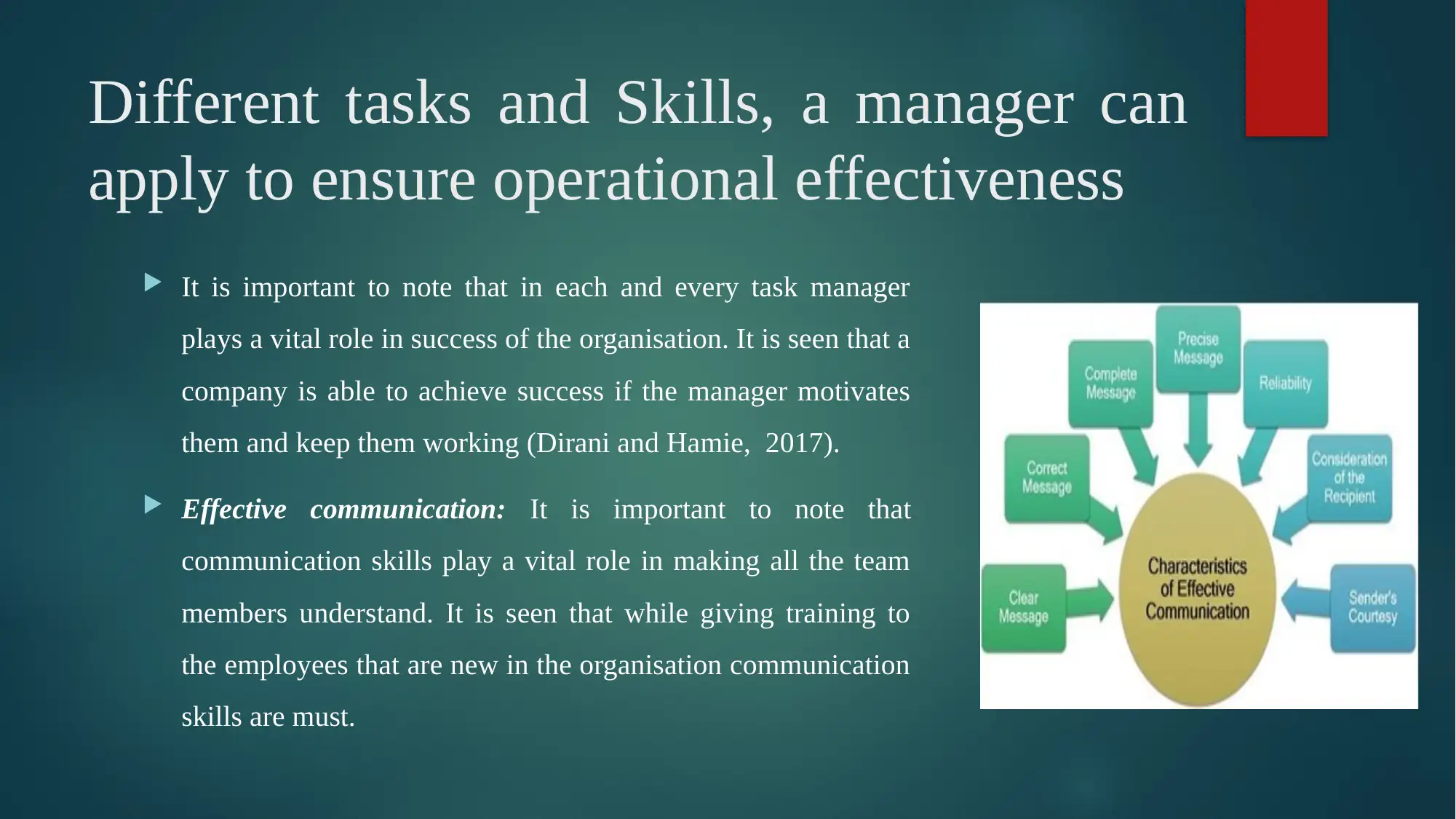
Different tasks and Skills, a manager can
apply to ensure operational effectiveness
It is important to note that in each and every task manager
plays a vital role in success of the organisation. It is seen that a
company is able to achieve success if the manager motivates
them and keep them working (Dirani and Hamie, 2017).
Effective communication: It is important to note that
communication skills play a vital role in making all the team
members understand. It is seen that while giving training to
the employees that are new in the organisation communication
skills are must.
apply to ensure operational effectiveness
It is important to note that in each and every task manager
plays a vital role in success of the organisation. It is seen that a
company is able to achieve success if the manager motivates
them and keep them working (Dirani and Hamie, 2017).
Effective communication: It is important to note that
communication skills play a vital role in making all the team
members understand. It is seen that while giving training to
the employees that are new in the organisation communication
skills are must.
⊘ This is a preview!⊘
Do you want full access?
Subscribe today to unlock all pages.

Trusted by 1+ million students worldwide
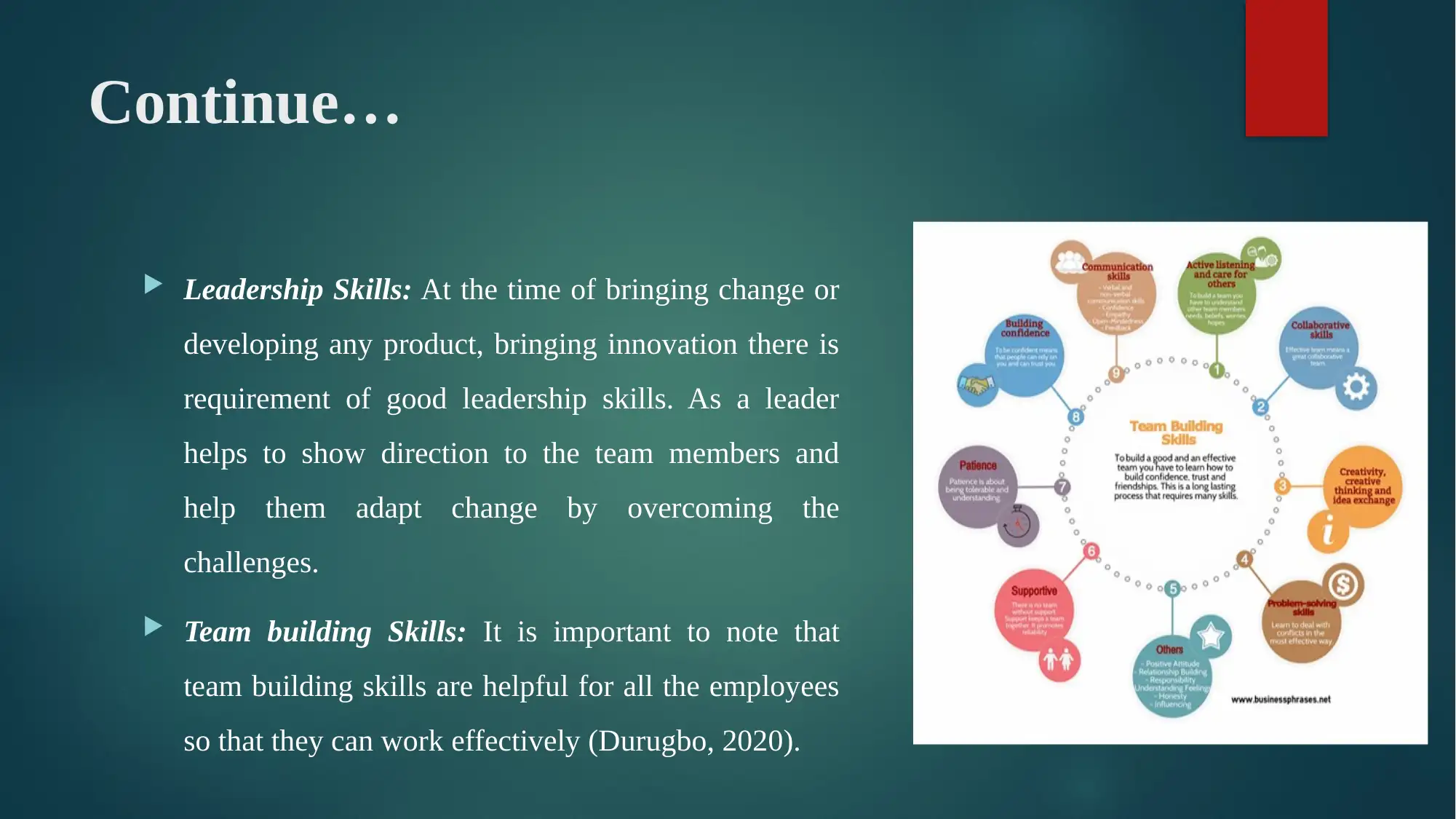
Continue…
Leadership Skills: At the time of bringing change or
developing any product, bringing innovation there is
requirement of good leadership skills. As a leader
helps to show direction to the team members and
help them adapt change by overcoming the
challenges.
Team building Skills: It is important to note that
team building skills are helpful for all the employees
so that they can work effectively (Durugbo, 2020).
Leadership Skills: At the time of bringing change or
developing any product, bringing innovation there is
requirement of good leadership skills. As a leader
helps to show direction to the team members and
help them adapt change by overcoming the
challenges.
Team building Skills: It is important to note that
team building skills are helpful for all the employees
so that they can work effectively (Durugbo, 2020).
Paraphrase This Document
Need a fresh take? Get an instant paraphrase of this document with our AI Paraphraser
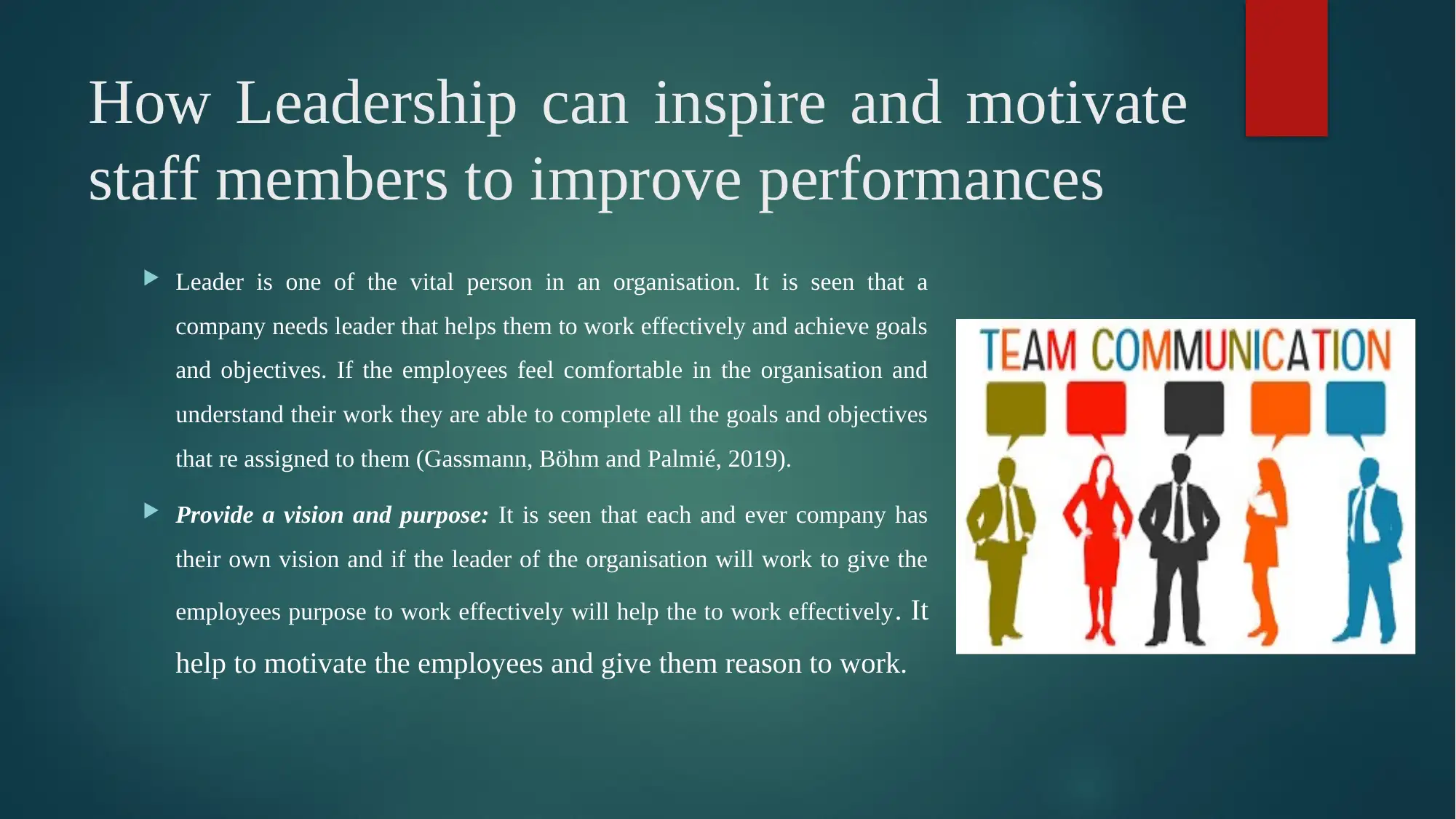
How Leadership can inspire and motivate
staff members to improve performances
Leader is one of the vital person in an organisation. It is seen that a
company needs leader that helps them to work effectively and achieve goals
and objectives. If the employees feel comfortable in the organisation and
understand their work they are able to complete all the goals and objectives
that re assigned to them (Gassmann, Böhm and Palmié, 2019).
Provide a vision and purpose: It is seen that each and ever company has
their own vision and if the leader of the organisation will work to give the
employees purpose to work effectively will help the to work effectively. It
help to motivate the employees and give them reason to work.
staff members to improve performances
Leader is one of the vital person in an organisation. It is seen that a
company needs leader that helps them to work effectively and achieve goals
and objectives. If the employees feel comfortable in the organisation and
understand their work they are able to complete all the goals and objectives
that re assigned to them (Gassmann, Böhm and Palmié, 2019).
Provide a vision and purpose: It is seen that each and ever company has
their own vision and if the leader of the organisation will work to give the
employees purpose to work effectively will help the to work effectively. It
help to motivate the employees and give them reason to work.
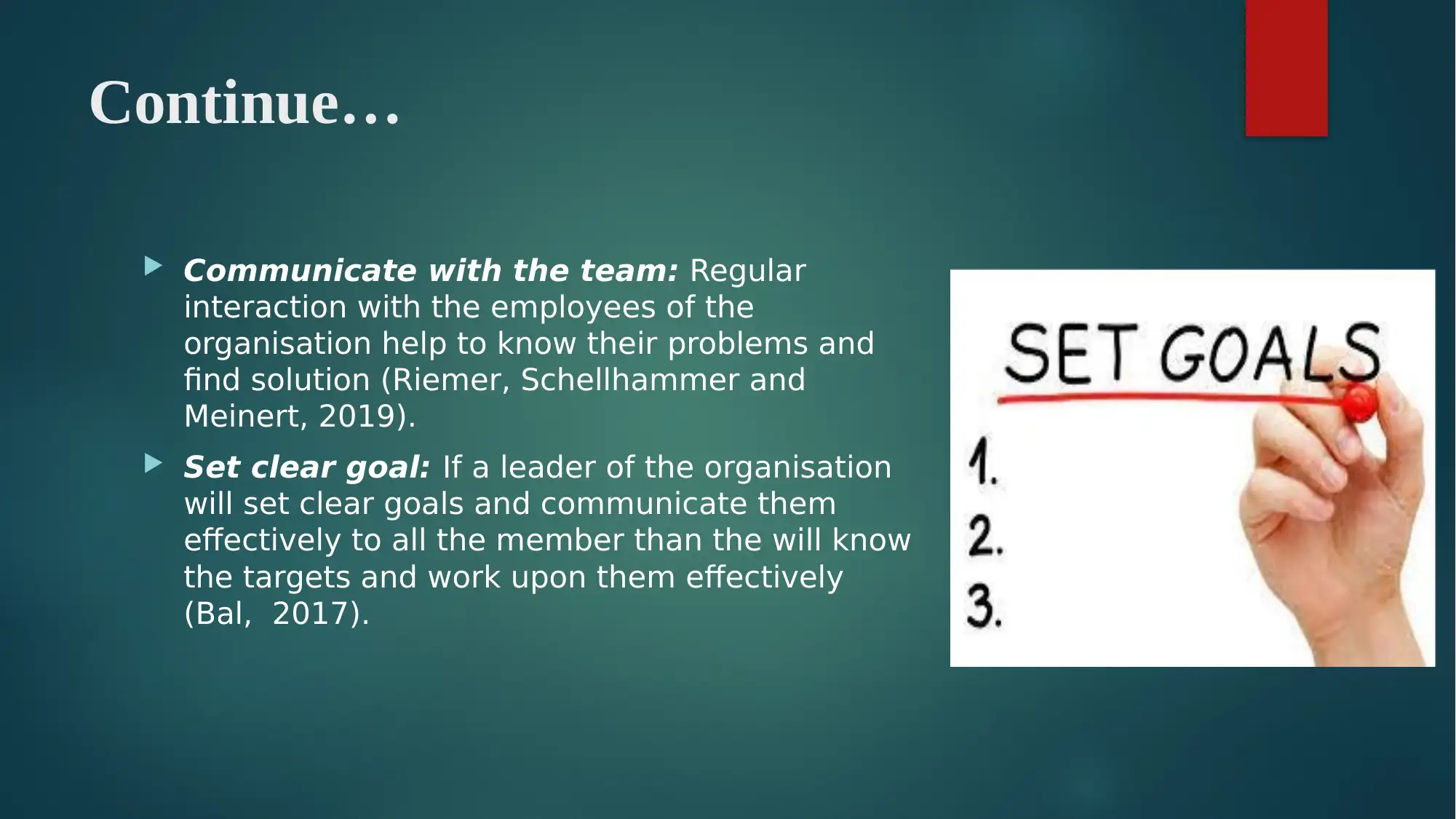
Continue…
Communicate with the team: Regular
interaction with the employees of the
organisation help to know their problems and
find solution (Riemer, Schellhammer and
Meinert, 2019).
Set clear goal: If a leader of the organisation
will set clear goals and communicate them
effectively to all the member than the will know
the targets and work upon them effectively
(Bal, 2017).
Communicate with the team: Regular
interaction with the employees of the
organisation help to know their problems and
find solution (Riemer, Schellhammer and
Meinert, 2019).
Set clear goal: If a leader of the organisation
will set clear goals and communicate them
effectively to all the member than the will know
the targets and work upon them effectively
(Bal, 2017).
⊘ This is a preview!⊘
Do you want full access?
Subscribe today to unlock all pages.

Trusted by 1+ million students worldwide
1 out of 21
Related Documents
Your All-in-One AI-Powered Toolkit for Academic Success.
+13062052269
info@desklib.com
Available 24*7 on WhatsApp / Email
![[object Object]](/_next/static/media/star-bottom.7253800d.svg)
Unlock your academic potential
Copyright © 2020–2025 A2Z Services. All Rights Reserved. Developed and managed by ZUCOL.





